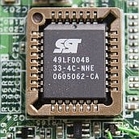What is the full form of BIOSBIOS: Basic Input Output System
BIOS stands for Basic Input Output System. It is built-in software. It is the first software run by the computer when you turned on your computer system. This software is usually stored in Read Only Memory (ROM) and located on the motherboard. In modern computer systems, the BIOS contents are stored in flash memory. It is not possible for an operating system to continue without BIOS as it is the BIOS that loads the drivers of the hard disk and primary portions of the operating system like MBR, FAT, GPT etc, into the memory to enable the operating system to continue loading itself. It is also known as System BIOS, ROM BIOS, PC BIOS etc. HistoryBIOS first appeared in the CP/M operating system in 1975. The term BIOS was invented by Gary Kildall. Functions of BIOSThe main function of the Basic Input Output System (BIOS) is to initialize and test all hardware components attach to the computer and load the part of the operating system. BIOS also provide a medium which facilitates the application programs and operating system to interact with the keyboard, display and other I/O devices. Following is a list of activities performed by BIOS:
The steps below should be followed to enter BIOS setup:
BIOS SetupIt is a configuration program that permits us to configure hardware settings. BIOS setup is also known as CMOS setup. BIOS or CMOS setup includes:
Next TopicFull Form
|
 For Videos Join Our Youtube Channel: Join Now
For Videos Join Our Youtube Channel: Join Now
Feedback
- Send your Feedback to [email protected]
Help Others, Please Share










